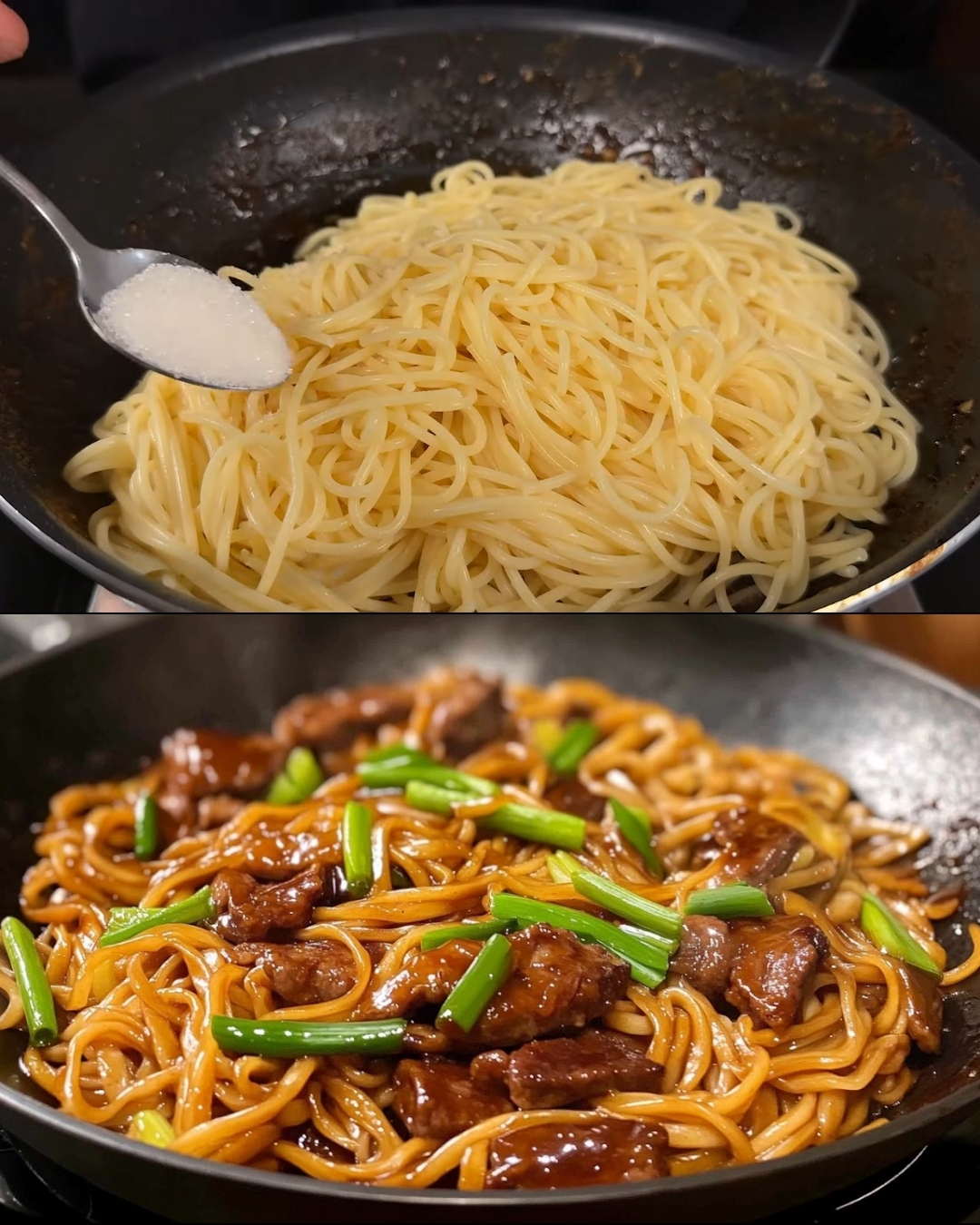East-meets-West comfort food at its finest: fork-twirling strands of al-dente spaghetti tangled with velvet-tender beef strips, caramel-sweet onions, and an umami-rich garlic–soy glaze that clings to every noodle. A quick cornstarch marinade borrowed from Cantonese stir-fries transforms budget beef into melt-in-the-mouth morsels, while oyster sauce deepens the savory base with a subtle oceanic sweetness. A scattering of fresh scallions brightens the dish, and a finishing drizzle of fragrant olive oil nods to the Italian roots of the pasta. Ready in under 45 minutes—including marinating time—this one-wok wonder delivers the nostalgic warmth of spaghetti night plus the punchy flavors of your favorite take-out, all in a single bowl.
Fast Facts
| Prep Time | 15 minutes (+ 30 minutes passive marinating) |
| Cook Time | 15 minutes |
| Total Time | 45 minutes |
| Yield | 4 generous servings |
| Cuisine | Asian-Italian fusion |
| Skill Level | Beginner-friendly |
Ingredients
Beef & Marinade
-
400 g beef sirloin or flank steak, sliced thinly across the grain
-
1 Tbsp light soy sauce
-
1 Tbsp oyster sauce
-
1 tsp granulated sugar
-
1 tsp baking soda
-
1 tsp cornstarch
-
50 ml water
-
1 Tbsp olive oil
Noodles & Aromatics
-
200 g dried spaghetti
-
1 tsp sea salt (for pasta water)
-
2 Tbsp olive oil, divided
-
1 medium yellow onion, sliced pole-to-pole
-
2 garlic cloves, minced
-
2 green onions, cut into 4 cm batons (reserve some tops for garnish)
Finishing Sauce
-
2 Tbsp light soy sauce
-
1 tsp granulated sugar
Step-by-Step Directions
-
Tenderize & Marinate the Beef
In a medium bowl whisk soy sauce, oyster sauce, sugar, baking soda, cornstarch, and water until smooth. Add beef and massage marinade into every strip. Drizzle with 1 Tbsp olive oil, toss, and let stand 30 minutes (room temperature) or up to 4 hours refrigerated. -
Cook the Spaghetti
Bring 3 L of water to a rolling boil. Add 1 tsp salt and spaghetti; cook 1 minute shy of package directions for firm al dente (about 8 minutes). Reserve ½ cup pasta water, then drain. -
Sear the Beef
Heat 1 Tbsp olive oil in a large wok or deep skillet over high heat until shimmering. Spread half the beef in a single layer; sear 45 seconds per side until browned but still juicy. Transfer to a plate, repeat with remaining beef. Do not wipe pan—fond equals flavor. -
Aromatics & Onions
Lower heat to medium-high, add remaining 1 Tbsp olive oil plus onion. Stir-fry 2 minutes until edges char slightly. Add garlic; cook 30 seconds fragrant. -
Bring It Together
Return beef plus any juices, add green-onion batons, soy sauce, sugar, and ¼ cup pasta water. Toss. Immediately add drained spaghetti. Stir-fry 1–2 minutes, lifting and folding so noodles soak up sauce. Splash in extra pasta water if dry; you want a glossy coating. -
Finish & Serve
Off heat, drizzle a final glug of olive oil for silkiness. Plate twirled nests in warm bowls; garnish with sliced green-onion tops. Serve hot.
Nutritional Information (per serving)
-
Calories : 540
-
Protein : 31 g
-
Carbohydrates : 55 g (Fiber 3 g)
-
Fat : 22 g (Sat 6 g)
-
Sodium : 980 mg
Estimates calculated with sirloin and standard soy sauce.
Origins & Popularity
Asian-Italian mash-ups date to post-war Hong Kong cha-chaan-teng cafés, where imported tinned tomatoes and local noodles birthed “spaghetti bolognese” with soy sauce. Filipino “sweet spaghetti” and Japanese “wafu pasta” soon followed. Western steak-and-pasta lovers, meanwhile, embraced soy-marinated beef in the 1990s as food courts popularized teriyaki bowls. Today, TikTok chefs routinely stir-fry linguine with gochujang or miso, proving that the pasta-plus-wok romance is more vibrant than ever.
Reasons You’ll Love It
-
Week-Night Speed – thirty minutes marination, fifteen minutes stove-time—dinner is done.
-
Tender Steak Every Time – baking soda alkalizes, cornstarch locks juices.
-
Pan-try Friendly – no exotic ingredients; soy and oyster sauce live in most cupboards.
-
One-Pan Clean-Up – seared, sauced, and tossed in a single wok.
-
Crowd Flexibility – double beef, swap noodles, or add veg without fuss.
Health Benefits
-
Lean Protein – sirloin offers iron, zinc, and B-vitamins for muscle repair.
-
Complex Carbs – spaghetti fuels sustained energy; choose whole-wheat for extra fiber.
-
Allium Antioxidants – garlic and onions bring allicin, linked to heart health.
-
Controlled Sodium – homemade sauce uses far less salt than take-out equivalents.
Serving Suggestions
-
Top with toasted sesame seeds and a soft-poached egg for richness.
-
Serve alongside quick-pickled cucumbers or a crisp Asian slaw.
-
Turn leftovers into next-day wraps with shredded lettuce and sriracha mayo.
Common Mistakes to Avoid
-
Skipping the Beef Dry-Patch – waterlogged meat steams instead of sears; pat slices with paper towel before cooking.
-
Crowding the Wok – work in batches to maintain high heat.
-
Over-Marinating – more than 4 hours in baking-soda mix can give beef a mushy texture.
-
Neglecting Pasta Water – starch-rich liquid is key to emulsifying the sauce.
Pairing Recommendations
-
Drink – a fruit-forward Pinot Noir or an ice-cold lager tempers umami.
-
Side – stir-fried baby bok choy with garlic chips adds crunch and greens.
-
Dessert – finish with sliced mango or lychee sorbet for a fresh palate cleanse.
Cooking Tips
-
Partially freeze steak 20 minutes for paper-thin slicing.
-
Swirl soy sauce around hot pan edges (“wok hei”) before tossing noodles for smoky depth.
-
Cut onions pole-to-pole; they retain shape and caramelize better than crosswise rings.
-
Use tongs for tossing—the grip reduces noodle breakage.
Variations
-
Veg-Heavy – toss in bell-pepper strips, snow peas, or broccoli florets after onions.
-
Spicy Szechuan – add 1 Tbsp chili bean paste and a pinch of Sichuan peppercorns with garlic.
-
Chicken or Tofu – substitute thin-sliced thigh meat or pressed tofu; keep marinade identical.
-
Gluten-Free – rice noodles plus tamari instead of wheat spaghetti and soy.
Similar Recipes to Try
-
Beef Yakisoba with Cabbage & Carrot
-
Black Pepper Udon with Strip Steak
-
Garlic Shrimp Linguine in Miso-Lime Butter
-
Korean Bulgogi Penne Bake
Ingredient Spotlight
Oyster Sauce – Invented in 1888 by Lee Kam Kee, this thick brown condiment is made from oyster extracts, sugar, salt, and cornstarch. It delivers umami, subtle sweetness, and sheen, making it a staple in Cantonese stir-fries and now in fusion pastas like this one.
Advertisement
Conclusion
Savory Beef & Garlic Soy Spaghetti bridges culinary cultures with ease: Italian noodles, Chinese velvet beef, and pantry sauces dance together for a dinner that feels both comfortingly familiar and excitingly new. With simple steps, minimal cleanup, and crowd-pleasing flavors, it’s bound to enter your week-night rotation—proof that quick meals needn’t sacrifice depth or delight.
Frequently Asked Questions
-
Can I use another cut of beef? Flank, skirt, or flat-iron steak also work—slice thin and across the grain.
-
Is baking soda mandatory? It’s optional but highly recommended for tenderness; omit if you prefer natural chew.
-
What pasta shapes substitute well? Linguine, fettuccine, or even ramen bricks (cooked) adapt nicely.
-
How spicy is the dish? Mild as written; add chili flakes or sambal for heat.
-
Can I meal-prep this? Yes—store sauce-coated noodles separate from beef; reheat quickly in a wok with a splash of water.
-
Why reserve pasta water? Its starch turns oil and soy into a silky emulsion that clings to noodles.
-
Is oyster sauce vegetarian? Traditional brands aren’t; for veggie versions use mushroom “oyster” sauce.
-
Can I grill the beef instead? Absolutely—sear marinated strips over high heat, then slice and toss with noodles.
-
How long will leftovers keep? Refrigerate in an airtight container up to 3 days; pan-fry to re-crisp beef.
-
Can I lower the sodium? Choose reduced-sodium soy, omit added salt, and rinse noodles briefly before tossing.

